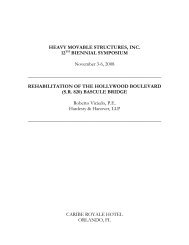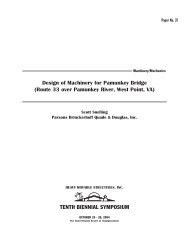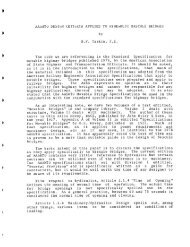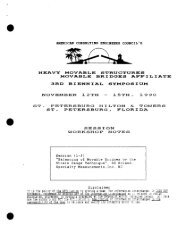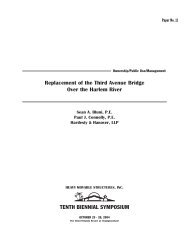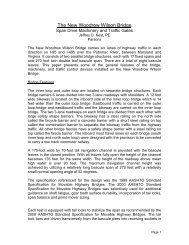Hydraulic Slewing Drives for the Coleman Swing Span Bridge
Hydraulic Slewing Drives for the Coleman Swing Span Bridge
Hydraulic Slewing Drives for the Coleman Swing Span Bridge
Create successful ePaper yourself
Turn your PDF publications into a flip-book with our unique Google optimized e-Paper software.
Heavy Movable Structures, Inc.<br />
SIXTH BIENNIAL SYMPOSIUM<br />
October 30 - November 1,1996<br />
Doubletree Resort Surfside<br />
Cleanvater Beach, Florida<br />
<strong>Hydraulic</strong> <strong>Slewing</strong> <strong>Drives</strong> <strong>for</strong> <strong>the</strong><br />
<strong>Coleman</strong> <strong>Swing</strong> <strong>Span</strong> <strong>Bridge</strong><br />
Lou Wendel, Flender Corporation
HYDRAULIC SLEWING DRIVES<br />
<strong>for</strong> <strong>the</strong><br />
COLEMAN SWING SPAN BRIDGE<br />
Lou Wendel<br />
FLENDER Corporation<br />
Elgin, Illinois, U.S.A.<br />
Prepared 8/96
ABSTRACT<br />
Many factors must be considered when choosing a reliable, efficient and<br />
environmentally acceptable bridge drive system. Control of speed, direction, and<br />
torque, reversing and braking, system efficiency and maintenance are just a few areas<br />
that movable bridge design engineers must address when evaluating a drive system.<br />
<strong>Hydraulic</strong> drives possess <strong>the</strong> necessary characteristics <strong>for</strong> a reliable bridge drive system.
INTRODUCTION<br />
Today's modern hydraulic systems provide many features that are desirable <strong>for</strong> movable<br />
bridge applications. By <strong>the</strong>ir very nature, hydraulic drives provide a soft start<br />
characteristic negating harmful mechanical shock. When efficient driving and braking<br />
are required in both directions,<strong>the</strong> drives are generally known as four-quadrant drives.<br />
<strong>Hydraulic</strong> drives can accelerate, brake and reverse as a standard feature with braking<br />
torque effectively achieved with <strong>the</strong> hydraulic motor working as a pump against a<br />
hydraulic counterbalance.<br />
<strong>Hydraulic</strong> drives generally require less servicing as <strong>the</strong>y are enclosed units, protected<br />
from <strong>the</strong> environment with maintenance confined to periodic replacement of <strong>the</strong><br />
hydraulic filter elements.<br />
Simplicity of <strong>the</strong> back-up systems as well as flexibility of space engineering allow <strong>the</strong><br />
hydraulic power unit to be placed in an optimized location. Major drive components<br />
such as <strong>the</strong> electric motor, hydraulic motor, pump, valving and electronic components<br />
are typically standard catalog items.<br />
Engineers in <strong>the</strong> bridge industry are beginning to recognize <strong>the</strong> advantages of using<br />
hydraulic drives. Technological advances of <strong>the</strong> past decade have enabled hydraulic<br />
systems to enhance bridge machinery per<strong>for</strong>mance in many areas including operating<br />
flexibility, reliability, energy efficiency and long component life.<br />
The purpose of this paper is to familiarize <strong>the</strong> reader with:<br />
Components of <strong>the</strong> slewing unit<br />
Center distance adjustment housing<br />
AAHSTO standards as applied to hydraulic systems<br />
<strong>Hydraulic</strong> circuit design and operation as applied to <strong>the</strong> <strong>Coleman</strong> <strong>Bridge</strong><br />
Environmental responsibility
BRIDGE VITAL STATISTICS<br />
The 3,750 foot <strong>Coleman</strong> <strong>Bridge</strong> is <strong>the</strong> largest double-swing bridge in <strong>the</strong> United States<br />
and <strong>the</strong> second largest in <strong>the</strong> world. It is part of Route 17 which traverses <strong>the</strong> York<br />
River at historic Yorktown, Virginia. The new bridge design was done by Parsons,<br />
Brinckerhoff, Quade and Douglas, Inc., of New York. The bridge was built <strong>for</strong> <strong>the</strong><br />
Virginia Department of Transportation by Tidewater Construction Corporation of Norfolk,<br />
Virginia. The swing span hydraulic bridge machinery was engineered and supplied by<br />
FLENDER Corporation of Elgin, Illinois.<br />
The twin swing span statistics are:<br />
Length of swing spans - 500 feet each<br />
Weight of swing spans - 4,128 tons each<br />
Time requirements - 270 seconds to fully open position<br />
- 270 seconds to fully close position<br />
Page 1
HYDRAULIC BRIDGE MACHINERY<br />
The actuation of <strong>the</strong> individual swing span is accomplished by <strong>the</strong> use of four<br />
hydraulically driven slewing units. This provides redundancy as each slewing unit can<br />
be isolated from <strong>the</strong> hydraulic circuit by manually controlled ball valves and<br />
mechanically isolated by removing <strong>the</strong> respective pinion gear. The four slewing units<br />
are located in <strong>the</strong>ir respective quadrant such that <strong>the</strong>ir pinions are driving against an<br />
externally geared rack. The rack diameter is 601.60 inches.<br />
Figure 1 shows a slewing unit which is comprised of three (3) integral elements. The low<br />
speed high torque radial piston hydraulic motor, <strong>the</strong> single stage planetary reducer with<br />
drive shaft, drive shaft housing and lower bearing assembly. A fail safe, pressure<br />
released, totally enclosed multi-disc brake is <strong>the</strong> third element integral to each unit.<br />
The low speed high torque radial piston motor is a multi-cam lobe design; eight lobes<br />
with fifteen piston assemblies providing 120 power strokes per revolution <strong>for</strong> smooth<br />
ripple free torque output. It is an industrial class hydraulic motor <strong>for</strong> use in stationary<br />
applications. The cam ring is constructed of 17 CrNiMo6 (AISI 8620) gear steel which<br />
is carburized and ground <strong>for</strong> hardening. Pistons, also made of AlSl 8620 gear steel, are<br />
carburized, and being mechanically free, operate with no radial load within its cylinder<br />
block bore. The dual, plate-type oil distributor ring design, produces <strong>the</strong> highest<br />
volumetric efficiency of any design and is free from damage caused by <strong>the</strong>rmal shock.<br />
Distributor rings are constructed of 34 CrNiMo6 and are nitrited <strong>for</strong> wear resistance and<br />
long life. Cam follower roller bearings are large in relationship to <strong>the</strong> piston area, thus<br />
producing long life.<br />
Few parts contribute to high reliability and simplicity. Mechanical efficiency of <strong>the</strong> motor<br />
is 93% starting and 96% running.<br />
The planetary is a single stage torque multiplier, industrial class, with a 5.437:1 ratio.<br />
In combination with its hydraulic motor <strong>the</strong> resultant torque is 305,400 in-lb/1000 psi<br />
Page 2
HYDRAULIC BRIDGE MACHINERY<br />
(continued)<br />
with a displacement of 1919 in3/revolution. The planetary has a torque rating, of<br />
699,000 Ib-in. Planet and sun gears have spur gearing that are manufactured of alloyed<br />
case hardened steel and ground, <strong>the</strong> ring gear is made of quenched and tempered<br />
steel. Planetary gear design allows <strong>for</strong> large transmittable power ratings per unit size<br />
combined with low overall weight. Weight of <strong>the</strong> individual slewing unit is 6000 pounds.<br />
A totally enclosed, pressure released, multi-disc brake is incorporated <strong>for</strong> use primarily<br />
as a parking brake. It is sized so that it may also be used as an emergency brake in<br />
<strong>the</strong> event that total electrical service to <strong>the</strong> bridge is lost. The span(s) will come to a<br />
controlled stop in five seconds under <strong>the</strong>se conditions. Braking <strong>for</strong>ce <strong>for</strong> each pinion<br />
gear is 156,500 Ib.-ft. A manually operated hydraulic pump is also provided. Its<br />
function is to release <strong>the</strong> brakes should main system hydraulic pressure not be<br />
available.<br />
Page 3
The anti-backlash housing is a center distance adjustment fabrication which ensures<br />
proper bridge pinion and ring gear contact. The assembly is pictured in Figures 2 and<br />
3. The slewing unit is lowered into and bolted to <strong>the</strong> backlash housing via flanges. The<br />
anti-backlash housing has its own pilot, bolt circle pattern and flange which is placed<br />
into position in <strong>the</strong> bridge span structure. The entire assembly is <strong>the</strong>n slightly rotated<br />
until correct bridge gear tooth contact is achieved. The anti-backlash assembly is <strong>the</strong>n<br />
firmly bolted in place. This technique allows <strong>for</strong> future adjustments to compensate <strong>for</strong><br />
pinion and ring gear tooth wear. Maximum transmittable power is 288 HP per slewing<br />
unit, although all four slewing units are driven by one, 75 HP prime mover. This is due<br />
in-part to <strong>the</strong> conservative natural of <strong>the</strong> AAHSTO standards, allowable operating<br />
pressures, primarily designed <strong>for</strong> hydraulic cylinder applications on movable bridges.<br />
AAHSTO ARTICLE 2.5.18 HYDRAULIC SYSTEMS and COMPONENTS<br />
This article defines allowable system pressures as follows:<br />
NORMAL OPERATION ...................................... 1000 psi<br />
OPERATION AGAINST MAXIMUM SPECIFIED LOADS . ............. 2000 psi<br />
HOLDING AGAINST MAXIMUM SPECIFIED WIND LOADS ........... 3000 psi<br />
NORMAL OPERATION shall be defined as operation against Condition A loads<br />
specified in ARTICLE 2.5.3.<br />
OPERATION AGAINST MAXIMUM SPECIFIED LOADS shall be defined as operation<br />
against Conditions B & C loads specified in ARTICLE 2.5.3.<br />
HOLDING AGAINST MAXIMUM SPECIFIED WIND LOADS shall be defined as holding<br />
<strong>the</strong> movable span in <strong>the</strong> fully open position, static condition, against <strong>the</strong> loads in Article<br />
2.5.3.E.<br />
Page 4
ANTI-BACKLASH HOUSING<br />
(continued)<br />
In <strong>the</strong> case of <strong>the</strong> <strong>Coleman</strong> <strong>Bridge</strong>, with an open gear ratio of 37.06, <strong>the</strong>se operational<br />
conditions translate as follows:<br />
CONDITION A of 1000 psi equals a gross torque load of 3832 kip-feet.<br />
CONDITIONS B & C of 2000 psi equals a gross torque load of 6494 kip-feet.<br />
CONDITION E of 3000 psi equals a gross torque load of 9227 kip-feet.<br />
The swing span travels through its 90" arc tk i;r fully open or fully closed position in 270<br />
seconds. It takes 20 seconds to accelerate <strong>the</strong> span(s) to speed, 200 seconds at<br />
speed, 20 seconds to decelerate to a creep speed of 30 second duration to a fully open<br />
or fully closed position. Under emergency stop conditions <strong>the</strong> swing span(s) will<br />
decelerate to a full stop in five seconds. <strong>Span</strong> duty cycle is typically 36 minutes per 24<br />
hour day.<br />
Page 5
HYDRAULIC CIRCUIT<br />
The hydraulic circuit, shown in figure 4, is of <strong>the</strong> open circuit design utilizing counter<br />
balance valving <strong>for</strong> deceleration control and proportional, three position four way valving<br />
<strong>for</strong> directional and speed control.<br />
The fluid power system incorporates redundancy at <strong>the</strong> power unit with an identical<br />
standby electric motorlhydraulic pump combination, which is isolated from <strong>the</strong> circuit<br />
by means of a check valve. The back-up pumplmotor can be brought into service<br />
instantly by a control switch on <strong>the</strong> bridge operators control console. Design of <strong>the</strong><br />
power unit, which is a heavy steel framed skid upon which is attached <strong>the</strong> redundant<br />
bed-plate mounted 75 HP electric motors and 266 cc hydraulic pumps, is shown in<br />
figures 5 and 6. The 400 gallon oil reservoir is of 316 stainless steel construction as<br />
well as is <strong>the</strong> manifold. Figure 7 shows <strong>the</strong> manifold block which contains <strong>the</strong> torque<br />
limiting cross-port relief valves, replenishing check valves, counterbalance valves and<br />
<strong>the</strong> attached proportional directional control valve. System monitors include:<br />
MONITOR<br />
Control Power<br />
Low Oil Level #I<br />
Low Oil Level #2<br />
Oil temperature 1 10@F<br />
High temperature 150@F<br />
Low oil pressure<br />
High oil pressure<br />
OUTPUT<br />
Lamp on<br />
Lamp on<br />
Lamp on & shutdown<br />
Lamp on<br />
Lamp on & shutdown<br />
Lamp on & shutdown<br />
Lamp on & shutdown<br />
LAMP<br />
Green<br />
Yellow<br />
Red<br />
Yellow<br />
Red<br />
Red<br />
Red<br />
<strong>Hydraulic</strong> oil is filtered on <strong>the</strong> pressure as well as <strong>the</strong> return side of <strong>the</strong> circuit to an IS0<br />
4406 cleanliness rating of 1411 2. During cold wea<strong>the</strong>r operations <strong>the</strong> oil is warmed with<br />
a 5kW immersion heater.<br />
<strong>Hydraulic</strong> control of <strong>the</strong> swing spans is accomplished by <strong>the</strong> interrelationship of a<br />
pressure compensated, horsepower limited, axial piston industrial class pump, counter<br />
balance valves, proportional directional control valves and cross-port relief valves. A<br />
discussion and explanation of <strong>the</strong> function of <strong>the</strong>se components is as follows:<br />
Page 6
HYDRAULIC CIRCUIT<br />
(Continued)<br />
Pressured Compensated - A pressure control valve whose primary function is<br />
to permit a pump to operate at minimum load. It is integral to <strong>the</strong> open circuit<br />
pump. Controlled by system pressure, displacement of <strong>the</strong> pump decreases as<br />
pressure increases, so that <strong>the</strong> pump output at <strong>the</strong> preset pressure is only<br />
sufficient to make up <strong>for</strong> leakage.<br />
Proportional Directional Control Valve - Typically a valve whose function is<br />
to direct flow through selected passages according to electronic reference<br />
signals. They operate in association with electronic driver cards which supply <strong>the</strong><br />
proportional valves with <strong>the</strong> correct current signal to modulate valve spool<br />
position to <strong>the</strong> referenced signal, in this application a t 10 volt DC signal. The<br />
electro hydraulic proportional control valves per<strong>for</strong>m both directional and speed<br />
control functions, through <strong>the</strong>ir ability to position infinitely an internal valve<br />
element to create an infinitely - variable orifice. This variable orifice throttles fluid<br />
flow to control load speed. Directional control of <strong>the</strong> hydraulic motor is<br />
accomplished much like that of a conventional solenoid - operated three position,<br />
four way valve.<br />
<strong>Hydraulic</strong> Counterbalancing - A counterbalance valve installed in <strong>the</strong> outgoing<br />
fluid line to keep <strong>the</strong> load (swing span) from getting ahead of <strong>the</strong> fluid supply.<br />
The valve is piloted from <strong>the</strong> upstream or pressure side of <strong>the</strong> motor.<br />
The use of a counterbalance valve provides a back pressure on <strong>the</strong> motor outlet,<br />
when needed, to prevent <strong>the</strong> load from <strong>for</strong>cing <strong>the</strong> motor to over-run <strong>the</strong> oil<br />
supply, <strong>the</strong>reby keeping <strong>the</strong> moving span, in a controlled state. During normal<br />
operation, when <strong>the</strong> hydraulic motor is driving <strong>the</strong> span, <strong>the</strong> pilot signal derived<br />
from <strong>the</strong> pressure side of <strong>the</strong> motor pilots <strong>the</strong> valve open and removes all back<br />
pressure from <strong>the</strong> motor outlet. During periods of deceleration, inlet pressure to<br />
<strong>the</strong> motor drops to zero and <strong>the</strong> counter balance valve is <strong>the</strong>n piloted open by<br />
back pressure from <strong>the</strong> motor outlet.<br />
Page 7
HYDRAULIC CIRCUIT<br />
(Continued)<br />
Horsepower Limiting - <strong>Hydraulic</strong> horsepower is a function of pressure and flow.<br />
The limiting valve, typically integral to <strong>the</strong> pump, will destroke <strong>the</strong> variable volume<br />
pump when system pressure approaches a preset value, <strong>the</strong>reby allowing motion<br />
at a reduced speed without exceeding <strong>the</strong> horsepower rating.<br />
Cross-Port Relief Valve - Most fluid power systems are designed to operate<br />
within a preset pressure range. This range is a function of <strong>the</strong> <strong>for</strong>ces that <strong>the</strong><br />
actuators in <strong>the</strong> system must generate to do <strong>the</strong> required work. Being able to<br />
control and limit <strong>the</strong>se <strong>for</strong>ces is essential. Relief valves are <strong>the</strong> safeguards which<br />
limit maximum pressure (torque) in a system, by diverting excess oil when<br />
pressures exceed preset limits.<br />
Page 8
As we all must be responsible <strong>for</strong> <strong>the</strong> health and well being of our environment it has<br />
become necessary <strong>for</strong> manufactures and suppliers in <strong>the</strong> hydraulic industry to attend<br />
to <strong>the</strong>se matters.<br />
Tremendous advances in <strong>the</strong> area of reliability, efficiency and leak prevention over <strong>the</strong><br />
last two decades have contributed significantly to this area of social concern. A recent<br />
development by major hydraulic oil manufacturers has brought to <strong>the</strong> market what is<br />
known as environmental awareness lubricants. They are biodegradable, virtually<br />
nontoxic anti wear hydraulic oils. These environmentally compatible oils provide<br />
characteristics necessary <strong>for</strong> today's hydraulic systems operating under moderate to<br />
severe conditions. They are <strong>for</strong>mulated from high-quality, vegetable oils and additives,<br />
which provide specific properties required in hydraulic fluids while satisfying <strong>the</strong><br />
stringent criteria <strong>for</strong> biodegradability and toxicity. This includes tests against EPA 560/6-<br />
82-003 and <strong>the</strong> European OECD 301 <strong>for</strong> biodegradability, which states that 60 percent<br />
minimum biodegradability <strong>for</strong> 28 days being recognized as readily biodegradable. The<br />
toxicity is also tested against <strong>the</strong> EPA 56016-82-002 and <strong>the</strong> European OECD 203: 1-12.<br />
The environmentally compatible oils are presently available in IS0 VG 32 or 46.<br />
Page 9
On May 6, 1996 <strong>the</strong> twin spans of <strong>the</strong> new <strong>Coleman</strong> <strong>Bridge</strong> were actuated <strong>for</strong> <strong>the</strong> first<br />
of a series of successful trial openings. The Virginia Department of Transportation<br />
accepted ownership of <strong>the</strong> bridge later that month. This modern four lane movable<br />
bridge is equipped with today's highly reliable, industrial duty hydraulic and electronic<br />
system componentary.<br />
Long life, ease of maintenance, design flexibility, redundancy, environmental<br />
compatibility and operational assuredness are hallmarks of a desirable bridge drive<br />
system.<br />
Whe<strong>the</strong>r a new or rehabilitated bascule leaf or swing span bridge is to be constructed,<br />
<strong>the</strong> use of robust, industrial class hydraulic bridge machinery is a proven consideration<br />
when choosing a drive system <strong>for</strong> dynamic control of a moving span.<br />
-<br />
Page 10
1.3. SAC CWC 62<br />
UI6.7 TAPPIu I#aIs
Figure 2
. . Figure 3
Figure 4
4<br />
ru<br />
h)<br />
- Figure 5





